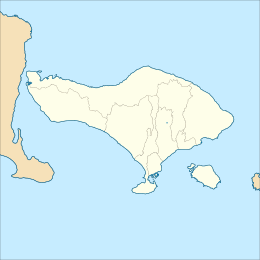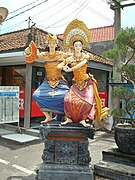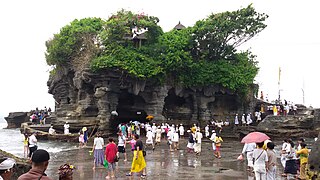Tanah Lot
 Pura Tanah Lot | |
| Geography | |
|---|---|
| Location | Indonesia |
| Coordinates | 8°37′16″S 115°05′14″E / 8.62107°S 115.08716°E |
Tanah Lot (Balinese: ᬢᬦᬄᬮᭀᬢ᭄) is a rock formation off the Indonesian island of Bali. It is home to the ancient Hindu pilgrimage temple Pura Tanah Lot (literally "Tanah Lot temple"), a popular tourist and cultural icon for photography.[1]
Location
Tanah Lot is in Beraban,[2] Kediri district, Tabanan Regency, approximately 13 kilometers (8 miles) south of Tabanan and 20 kilometres (12 mi) northwest of Denpasar. It sits on a large offshore rock and is only accessible on foot at low tide.[3]
- Tanah Lot
- Statue in Tanah Lot
- General view
- Nearby cliffs
- Rock formation
Tanah Lot temple
Tanah Lot means "Land [in the] Sea" in the Balinese language.[4][5] The main deity of the temple is Dewa Baruna or Bhatara Segara, who is the sea god or sea power. These days, Nirartha is also worshipped here.[6]
Tanah Lot is claimed to be the work of 16th-century religious figure Dang Hyang Nirartha, who was significantly influenced by Hinduism and who allegedly spent a night there in the course of his extensive travels in Bali, Lombok and Sumbawa.[a]
He is at the origin of the chain of sea temples that surrounds Bali. Each of the sea temples was established within eyesight of the next.[3]
Tanah Lot is one of the seven main sea temples,[8] located along the south-western coast

The Tanah Lot temple is close to the Balinese mythology. At the base of the rocky island, venomous sea snakes are believed to guard the temple from evil spirits and intruders. The temple is purportedly protected by a giant snake, which was created from Nirartha's selendang (a type of sash) when he established the island.
Restoration
In 1980, the temple's rock face started to crumble and the area around and inside the temple was becoming dangerous.[9] The Japanese government then provided a loan to the Indonesian government of Rp 800 billion (approximately US$480 million[10]) to conserve the historic temple and other significant locations around Bali. As a result, over one-third of Tanah Lot's "rock" is actually cleverly disguised artificial rock created during the Japanese-funded and supervised renovation and stabilization program.
Tourism
According to a 2019 study, Tanah Lot is one of the most visited places in Indonesia, averaging 500,000 visitors each year.[11]
In 2024, entrance tickets cost Rp 30,000 for Indonesian nationals (Rp 20,000 for children 5-10 y.o.) and Rp 75,000 for foreigners (Rp 40,000 for children 5-10 y.o.).[12] Nowadays only Balinese Hindu visitors can climb the stairway to the temple.[3]
To reach the temple, visitors must walk through a set of Balinese market-format souvenir shops which cover each side of the path down to the sea. On the mainland clifftops, restaurants have also been provided for tourists.
The smaller Pura Mas Suka, at the southernmost tip of Bukit peninsula and of Bali, presents the same stunning setting on an off-shore cliff.
- Guardians of the gate
- Stair dragon
- Sacred water at Tanah Lot temple
- Odalan ritual
- Kecak Dance, August 14, 2022
See also
Notes and references
Notes
- ^ Dang Hyang Nirartha's travels in Bali, Lombok and Sumbawa are recounted in a lontara called Dwijendra Tatwa.[7] The Dwijendra Tatwa has been digitized and is available online in archive.org.
References
- ^ South-East Asia on a shoestring. Lonely Planet. 1992. p. 257. ISBN 0-86442-125-7. OCLC 12486944..
- ^ "Beraban, map". google.co.id.[dead link]
- ^ a b c "Temples In Bali Explained -The Guide For Beginners". greenerbali.com. Retrieved 2024-05-20.
- ^ Hirsch, Philip; Warren, Carol (1998). The politics of environment in Southeast Asia: resources and resistance (325 p.). London / New York: Routledge. pp. 242–244. ISBN 978-0-203-03017-2. OCLC 490091203.
- ^ Dougherty, Margaret (Fall 2018). "How the Balinese see the sea: interpretations of oceanic power". Independent Study Project (ISP) Collection (2934). Retrieved 2024-05-27. p. 35.
- ^ "Tanah Lot". balistarislad.com. Retrieved 2024-05-07.
- ^ Putra, Ida Bagus Rai; Kesuma, I Nyoman Weda; Cika, I Wayan; Suastika, I Made (January 2011). "Dharmayatra in the Dwijendra Tattwa text analysis of reception". e-Journal of Linguistics. 5 (2). Retrieved 2024-05-24.
- ^ Dougherty 2018, p. 7.
- ^ Pringle 2004, p. 192-194.
- ^ 1980 exchange rate of US $1 to Rp 6000 from Gordon De Brouwer, Masahiro Kawai. Indonesian Rupiah in Exchange rate regimes in East Asia Vol 51. Publisher: Routledge, 2004. ISBN 0-415-32281-2, ISBN 978-0-415-32281-2. 466 pages
- ^ Andriani, Agis; Fuad, Abdullah; Enjang, Nurhaedin; Hidayati, Arini Nurul; Rosmala, Dewi; Saputra, Yuyus (2004). "The Representation of Counterproductive Religious Values in a Selected Chapter of an Indonesian ELT Textbook: Systemic Functional Multimodal Discourse Analysis". Journal of Pragmatics and Discourse Research. 4 (1): 56. Retrieved 2024-05-27.
- ^ "Ticket prices". water-sports-bali.com. Retrieved 2024-05-27.
See also
Bibliography
- Pringle, Robert (2004). A short history of Bali: Indonesia's Hindu Realm. Short History of Asia cup. Crows Nest, NSW: Allen & Unwin. ISBN 1-86508-863-3.
External links
 Tanah Lot travel guide from Wikivoyage
Tanah Lot travel guide from Wikivoyage












